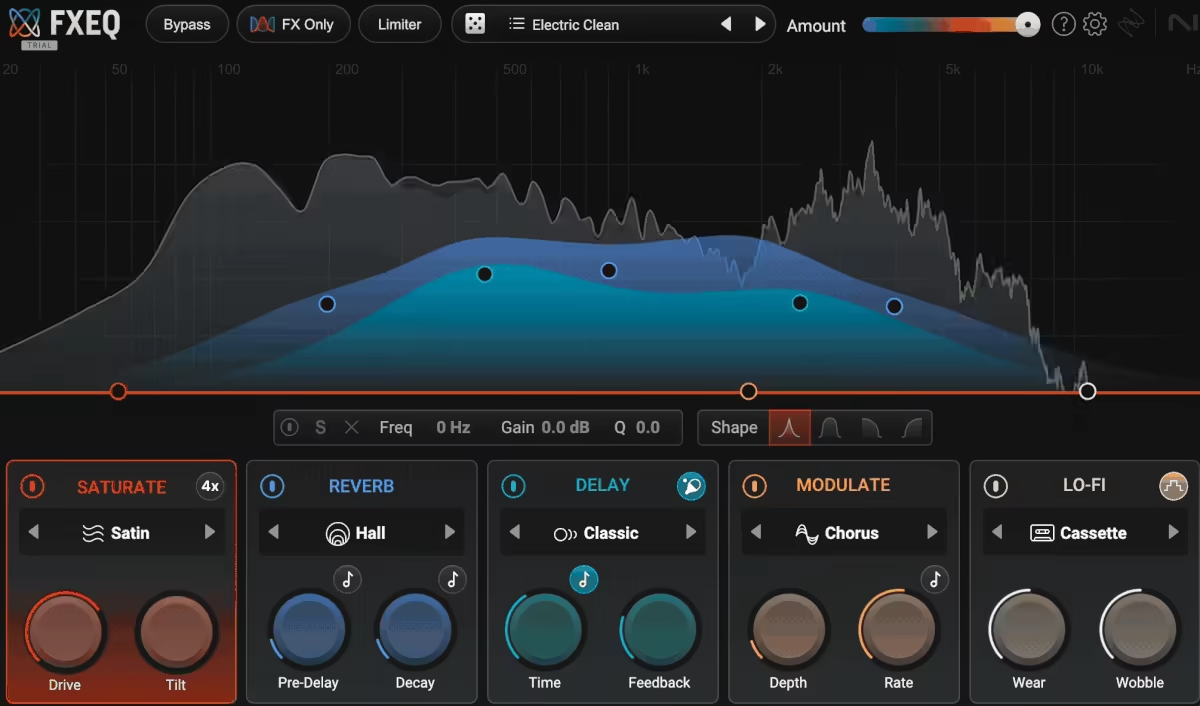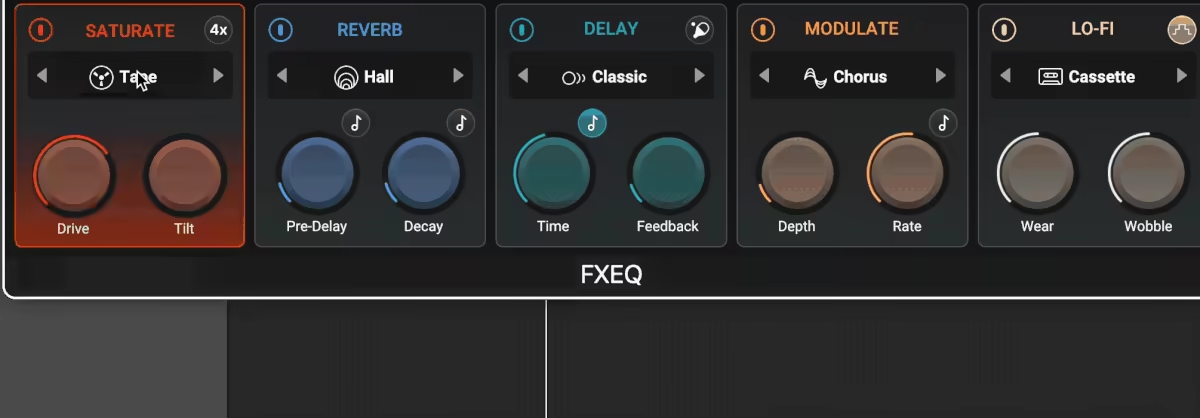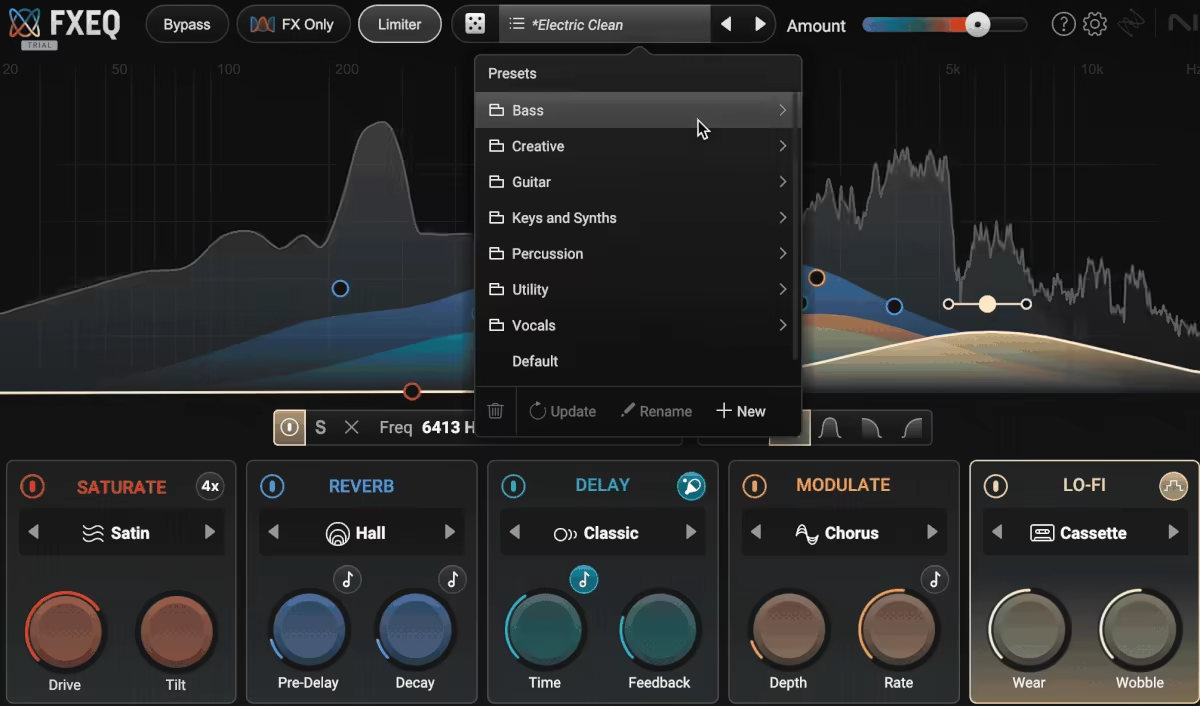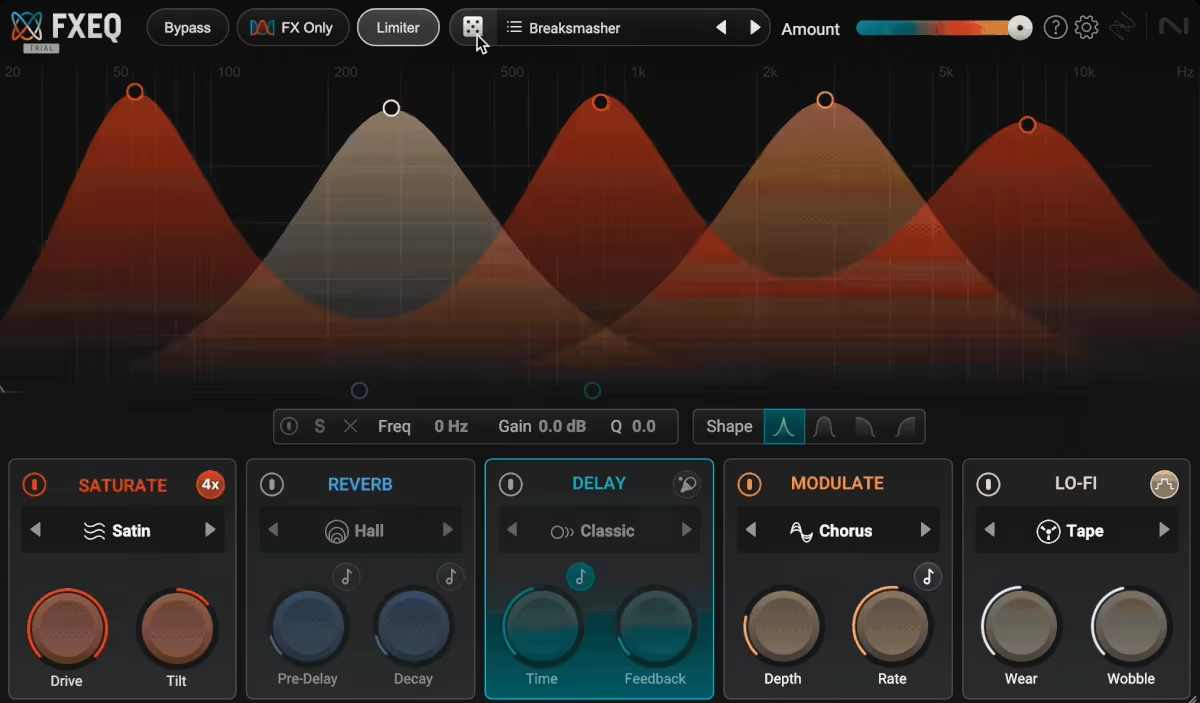iZotope FXEQ is a creative multi-effects plugin that lets you apply Saturation, Reverb, Delay, Modulation, and Lo-Fi effects to specific frequency ranges using an intuitive EQ-style interface. With low CPU usage, flexible automation, and precise control over each effect, FXEQ is ideal for mixing, sound design, and adding character to vocals, guitars, synths, and full mixes.
Price
Pros
- Intuitive Interface makes targeting frequency-specific effects effortless
- 5 Powerful Modules: Saturate, Reverb, Delay, Modulate, Lo-Fi
- Low CPU Usage, even with multiple tracks and heavy automation
- Wet/Dry Slider allows quick adjustments without undoing work
- Flexible Automation for evolving sounds over time
- EQ-Style Frequency Control for surgical precision
Cons
- Lo-Fi Module could have more drastic degradation options
- Reverse Delay can get muddy quickly
Today, we have iZotope FXEQ on the table for review. Let’s check if this new baby is worth the hype or not!
When I first opened FXEQ, I expected just another EQ plugin with a couple of shiny filters. Instead, it surprised me by acting more like a creative instrument. I wasn’t just pushing or cutting frequencies; I was shaping energy, pulling sounds apart, and gluing them back together in ways that felt alive.
What stood out right away was how natural it felt to experiment. Normally, EQing can feel like a technical chore, but here I found myself actually playing with the controls. It was less about “fixing problems” and more about discovering textures and movement I didn’t know my mixes were missing.
FXEQ also has this way of blurring the line between mixing and sound design. Sometimes I caught myself adding an EQ just for tone-shaping, but then realizing I was reshaping the entire mood of the track. It’s not the kind of tool you load up and forget, it demands a bit of exploration, but rewards you with sounds that feel like they’re bending in three dimensions.
That’s what made me curious to dig deeper: was this just a flashy EQ dressed up with effects, or something genuinely different? By the time I’d put it on a vocal, a synth bus, and even a drum loop, the answer became pretty clear. Let’s get into more detail!
Features
The FXEQ offers so much more than a regular equalizer plugin.
- EQ-Style Interface
What immediately stood out to me is how FXEQ flips the idea of EQ on its head. Instead of simply boosting or cutting the audio signal, you boost or cut the effects themselves. Each node on the curve is color-coded to a specific effect, so it’s crystal clear which frequency range is being processed. With 6 bands, four filter shapes, and adjustable Q, I feel like I’m painting sound rather than just mixing it.
- Saturation Modes
FXEQ gives me 8 flavors of saturation: Satin, Tape, Grit, Foldback, Snap, Bump, Steel, and Corrode. Each one has Drive and Tilt controls, so I can decide if I want smooth tape warmth, aggressive grit, or metallic edge. I’ve been using Tape for thickening bass, while Foldback gets wild on synths.
- Reverb
The Reverb module offers Hall, Chamber, and Plate, each with tweakable Pre-Delay and Decay. What I love most is targeting shimmer just in the high frequencies; suddenly, a vocal has air without the mix turning to mud. And syncing Pre-Delay to tempo keeps it locked into the groove.
- Delay
With 4 types, Classic, Reverse, Modulation, and Crunch, Delay is surprisingly versatile. The Crunch option adds a touch of distortion that works wonders on guitars, and the Ping-Pong toggle makes things instantly wider. Reverse felt less useful to me, but in a sound-design context, it’s got potential.
- Modulation
Chorus, Phaser, Flanger, and Doubler live here, but the beauty is applying them to specific ranges. Instead of drowning an entire pad in a sea of flange, I can just highlight the mids for subtle movement. Chorus on the top end of vocals gave me a sweet sparkle without washing everything out.
- Lo-Fi
If you’re into textures, this is gold with 4 flavors, Vinyl, Tape, Cassette, and Radio, with Wear and Wobble controls. It’s not as destructive as I hoped (I wanted full “broken tape machine” chaos), but it nails warm, nostalgic grit. Cassette mode is my go-to when I want something to feel a little less perfect.
- Global Touches
The horizontal Wet/Dry slider is genius. When I get carried away with stacking effects, one swipe lets me pull things back without killing the vibe. There’s also a zero-latency limiter to keep peaks under control, and FX Only mode, so I can hear just the processed signal. Combine that with DAW automation, and you can make sounds evolve beautifully over time.
Interface & Workflow
For me, the FXEQ interface felt modern and intuitive. The pastel colors on a dark background make it easy to identify which effect module is applied to each frequency range.
I found myself instinctively dragging nodes, adjusting curves, and experimenting with bands right away, it almost feels like “playing” with sound rather than tweaking knobs.
Each effect module like Saturation, Reverb, Delay, Modulation, Lo-Fi, is color-coded and has its own dedicated controls. I appreciate how the nodes respond in real time, showing the exact frequencies being affected, and the 4 filter shapes with adjustable Q give me precise control over how each effect interacts with the sound.
The Wet/Dry slider at the top is a subtle but powerful addition. It lets me dial back the intensity without undoing all the adjustments I’ve made, which encourages experimentation without fear of over-processing. I also rely on the Limiter button to keep extreme effects from clipping, ensuring my signal stays clean while pushing the plugin creatively.
In practice, FXEQ fits smoothly into my workflow. I often start with vocal or lead instruments, mapping out frequency ranges and stacking effects for presence, depth, and movement.
Then I move on to acoustic instruments or synths, adding shimmer, width, or texture exactly where it’s needed. Automating the modules over time allows sounds to evolve naturally, and because everything runs in parallel, my dry signal remains intact while the processed signal blends in seamlessly.
Overall, the workflow is fast, responsive, and intuitive, letting me experiment freely and get results far quicker than setting up separate EQ and effects chains in the DAW. FXEQ makes frequency-specific effects feel accessible, fun, and musical.
First Impressions & Sound
The first time I opened FXEQ, I found myself experimenting with nodes almost instinctively, dragging points around to see what each effect would do in real time. It’s rare that a plugin makes me feel like I’m actually “playing” with sound rather than just tweaking knobs.
I started with a simple vocal track, and within minutes I had added saturation only to the presence range, a subtle plate reverb on the highs, and a touch of delay filling the spaces between phrases. The clarity was immediate, nothing sounded over-processed, but the vocal now had depth and movement that I simply couldn’t get with a traditional EQ plus separate effects. I especially appreciated the Wet/Dry slider; it let me pull back a bit when I realized I was getting too ambitious without undoing all my work.
Next, I tried FXEQ on an acoustic guitar. Using tape saturation in the low mids added warmth, while a touch of shimmer in the high frequencies via the reverb gave the instrument more air without washing out the body of the sound.
Then I experimented with Lo-Fi Vinyl on the low end, subtle enough to add character, but without turning the track into a gimmick. I honestly felt like I had a palette of sonic colors at my fingertips, and I kept discovering new ways to shape the tone with precision.
Synths were next, and FXEQ really shined. I layered flanger on the mids and chorus on the top end, and suddenly the patch had movement and width I didn’t think was possible without multiple parallel chains in my DAW.
The Delay module’s Crunch mode added a gritty, textured pulse to a lead synth, while Ping-Pong modulation created stereo interest that felt musical, not distracting. Even using Reverse delay, which I personally wasn’t thrilled with, gave me new ideas for transitional effects and experimental textures.
What impressed me the most was how flexible FXEQ is without costing CPU cycles. On a full Ableton session, adding FXEQ to multiple tracks only nudged my processing by a few percent. It’s one of the few plugins that lets me explore sound design aggressively, automate every parameter, and still trust that my session won’t choke.
Overall, I think, FXEQ isn’t just functional; it inspires me to think differently about frequency-specific processing. Whether I’m polishing a vocal, adding character to acoustic instruments, or experimenting with synths, I find myself trying combinations I wouldn’t normally consider. It’s both a precise tool and a playground, and I’ve genuinely enjoyed spending hours just exploring what it can do.
Compatibility
| Platform | Supported OS | Plugin Formats |
| Mac | macOS 13.7 or later | AU, VST3, AAX |
| Windows | Windows 10 or later | VST3, AAX |
Final Words
iZotope FXEQ has quickly earned a spot in my personal toolkit. It’s rare that a plugin combines creativity, precision, and efficiency in such a seamless way. I’ve spent hours experimenting with different effect combinations, and every session feels inspiring rather than tedious.
The ability to target effects to specific frequency ranges completely changes how I approach mixing and sound design. Vocals, guitars, synths, each track suddenly has a new dimension without the need for multiple parallel chains in my DAW. I especially love how automation is effortless, letting tracks evolve over time in ways I wouldn’t have imagined before.
FXEQ isn’t just a utility, as it’s challenges me to think differently about frequency processing while still giving me complete control. Whether I’m polishing a vocal, adding texture to acoustic instruments, or experimenting with synths, I feel confident knowing I can shape my sound exactly the way I want.
In short, FXEQ inspires experimentation, encourages precision, and delivers professional results. I’ve genuinely enjoyed every minute exploring what it can do, and I can’t wait to see how it continues to transform my mixes.
Also consider reading our review on the iZotope Ozone 12.

Berk Öztuna, a musician from Istanbul, is skilled in handpan, percussion, and guitar, performing and recording his own compositions globally. With expertise in music production and audio technology, he integrates virtual instruments and sound design tools seamlessly into his work. He also writes insightful articles on music production and gear for platforms like Plugin Noise and shares his music on Spotify and Instagram.
DONATE: Love our content? Help us keep Plugin Noise alive in the age of AI — Your donation fuels better content for music creators like you! You can donate here: pluginoise@gmail.com (Every amount counts.)






